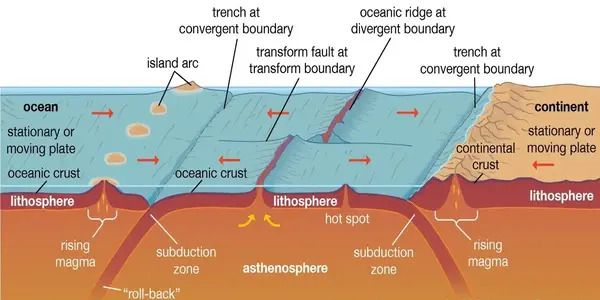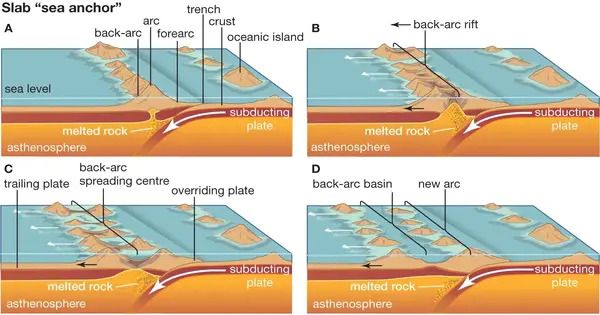Our planet’s lithosphere is divided into numerous tectonic plates. Their configuration is constantly changing as supercontinents assemble and disassemble, and oceans expand, grow, and then begin to close in what is known as the Wilson cycle.
An internal ocean forms when a supercontinent, such as Pangea, is broken apart during the Wilson cycle. Pangea’s interior ocean is the Atlantic. This ocean features a rift in the center and passive borders on each side, indicating that no seismic or volcanic activity occurs along its shores. An Atlantic-type ocean is destined to extend farther, eventually becoming the outside ocean of the next supercontinent. The Pacific is currently Earth’s outer ocean. The Pacific also has a rift in the middle, but it is bounded by subduction zones and thus will eventually close. Along its margins, earthquakes and eruptions abound — a pattern known as the ring of fire.
The ocean-closing phase of each Wilson cycle requires the transition from passive to active (subducting) margins at the edges of the interior ocean. The oceanic crust along the coast of the Atlantic is old and heavy, so it is primed to subduct, but before it can do so, it must break and bend. The only force in nature that can break oceanic plates like these is slab pull from another subduction zone.
But this doesn’t happen spontaneously. So how does subduction initiate around interior oceans?
These are some of the oldest pieces of crust on Earth, super strong and rigid — if it were any younger, the subducting plate would just break off and subduction would come to a halt. Still, it is just barely strong enough to make it, and thus moves very slowly.
Dr. Duarte
There are currently two subduction zones in the Atlantic: the Lesser Antilles and Scotia. However, neither of them developed spontaneously in the Atlantic; rather, they were pushed by subduction zones in the Pacific during the Cretaceous period and subsequently spread along transform borders, where the continent is narrow and there is little land bridge. They jumped oceans.
Today, on the eastern shore of the Atlantic, in Gibraltar, we can see the very early stages of this process, known as subduction invasion, while the jump occurs from a different basin — in this case, the Mediterranean.
This is an incredibly valuable opportunity because the chances of observing the very start of any given tectonic process are limited. Subduction initiation is difficult to observe because it leaves almost no traces behind. Once subduction starts, it erases the record of its initial stages; the subducted plate ends up in the mantle, never to be exposed at the surface again (except in the rare case of ophiolites).
The activity of the Gibraltar subduction zone in the Mediterranean has been hotly debated. The Gibraltar arc formed in the Oligocene as a part of the Western Mediterranean subduction zones. While we can see a subducted plate in the mantle underneath it, almost no further movement is currently happening.

A new paper by Duarte et al., just published in Geology, suggests that Gibraltar is active — it is just currently experiencing a slow movement phase because the subducting slab is very narrow, and it is trying to pull down the entire Atlantic plate.
“[These are] some of the oldest pieces of crust on Earth, super strong and rigid — if it were any younger, the subducting plate would just break off and subduction would come to a halt,” explains Duarte. “Still, it is just barely strong enough to make it, and thus moves very slowly.”
The authors’ new computational, gravity-driven 3-D model predicts that the sluggish phase will endure another 20 million years. Following that, the Gibraltar subduction zone will enter the Atlantic Ocean and accelerate. That will mark the start of crust recycling on the eastern side of the Atlantic, as well as the beginning of the Atlantic itself closing, ushering in a new phase in the Wilson Cycle.
Overall, this study demonstrates that subduction invasion, the process by which a new subduction zone forms in an exterior ocean and then migrates to an interior ocean, is a common mechanism of subduction initiation in Atlantic-type oceans and thus plays an important role in our planet’s geological evolution.
Locally, the discovery that the Gibraltar subduction is still active has significant consequences for seismic activity in the region. During this slow phase, recurrence intervals are projected to be quite lengthy, but there is still a risk of high-magnitude occurrences, such as the 1755 Lisbon earthquake, which necessitates preparation.
Much remains to be determined about the future of the Gibraltar arc. Duarte’s next priority will be to determine the actual geometry of the subduction zone, which will need measuring the relative strength of the nearby continental margin.
















